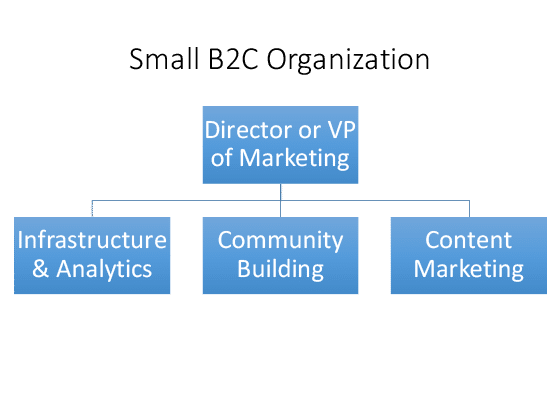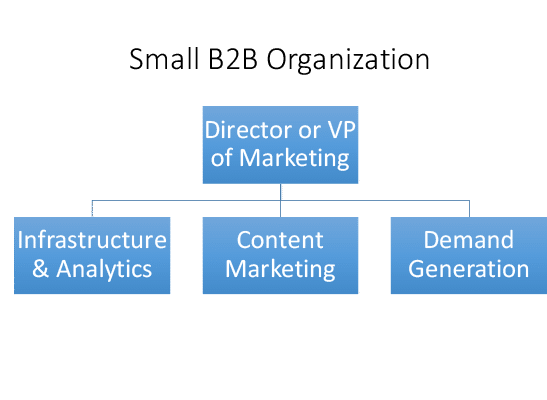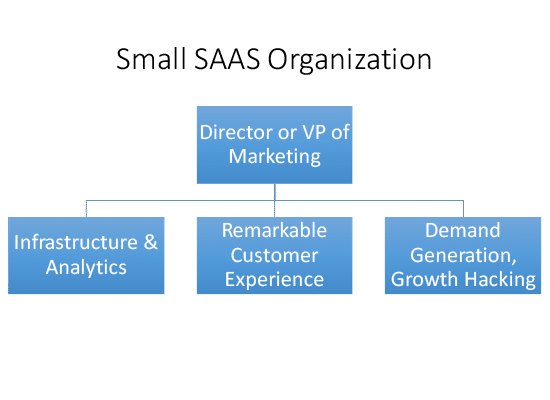I received a number of great comments on my last post, Organizing an Agile Marketing team. Several people commented that the organization presumed a large organization, aimed at business to business (B2B) marketing, with long lead times. To that, I plead guilty.
What if you have only enough resources for a small team? And what if you’re not marketing to businesses, but to consumers? How does that change the organization?
My Taxonomy
For the purpose of this post, I’m going to divide marketers into four groups based on a 2×2 grid: whether you’re marketing to businesses or consumers, and whether the sale takes place offline or online.
I’m not going to dive down into all the ways that marketing to consumers is different than marketing to businesses, or the differences that selling online versus offline make to marketing. I think these are pretty well established. The names for each quadrant seem fairly settled for me, with the possible exception of SAAS. If someone has a better name for online selling to businesses, let me know in the comments.
I think these are the critical dimensions that impact how your organize the team and the choices you make when you have limited resources.
B2C Marketing
How do you organize a small B2C team for modern, agile marketing? I’m going to assume that you have a leader (a Director or VP of Marketing) and 3 or 4 individuals. Here’s my recommendation:
I’m going to stand by my comment in my previous post that the first team should be the infrastructure & analytics team. I realize this may be controversial for B2C marketing, that many B2C companies don’t use CRM or marketing automation systems, but in my opinion, they should. Engage directly with your consumers through email. Analyze your promotional campaigns with analytics. You can’t do these things unless you have the infrastructure and the analytics to experiment, measure and improve.
I go back and forth as to whether community building or content marketing is next in importance. It probably depends on the business. Are you selling something that is expensive and a one-time or infrequent purchase where the buyer needs to be educated (pools, RVs)? Start with content marketing to educate your buyer. Are you selling inexpensive, repeat purchase items (cupcakes, coffee)? Start with community building. Both are important. The coffee house has an opportunity to educate the consumer about coffee through content marketing.
Someone is probably going to ask me where social media is in the organization and why it’s not a separate group? I think social media is a tool, and perhaps one of the most important tools of the community building group. But I’d rather not say to that group, your mission is social media. The mission of that group is to build community – whether they do that through social media, events, email or whatever means, the focus is on the mission not the tool.
B2B Marketing
I’ve spent most of my career in B2B marketing. My emphasis here is on modern, agile marketing, not a traditional B2B marketing organization. Here’s how I would organize a small B2B team:
Again, I’m going to begin with the infrastructure & analytics group. Next, I’m going to add a content marketing specialist, to feed the web site, the sales force and the demand generation activities. And lastly, I’m going to task someone with generating leads, whether that be through inside sales warm/cold calling, webinars, email campaigns or whatever. If I have a 4th person, I’m probably going to devote them to Remarkable Customer Experiences or product management.
eCommerce Marketing
I’m not talking about Amazon here, but about small eCommerce companies. Someone large enough to have a separate marketing team, but small enough that the team is 4 or 5 people. Here’s how I’d organize that team:
Again, start with infrastructure & analytics, with a particular emphasis on measuring conversions. Second, you need a team that really understands how to do A/B testing, generate conversions and generate fast growth, better known as growth hacking. They need to make sure those shopping carts get full and they check out. The third group is responsible for repeat purchases, and for identifying community functions that contribute to sales. Generating reviews is the most obvious example of this. But you also want to build a community of raving fans, who will buy more and attract more fans.
SAAS Marketing
If you’re a SAAS marketer, I’d highly recommend that you read The Nine Disciplines of Great SAAS Companies. After that, if you don’t have enough people to staff all those functions, here is my recommendation about where to start:
By now, you won’t be surprised that I think you should start with your infrastructure and analytics team. You need marketing automation, and you need to be able to measure your experiments. But the second part of the organization that I think you should staff for may be a surprise: the remarkable customer experience or product management team. I think this is critical for SAAS companies to get right. If the experience is remarkable, you’ll get your evangelists, you’ll get repeat business, and some level of demand generation will happen on its own. If you don’t get this right, your demand generation group will just be spreading bad experiences with your product or service.
I went back and forth as to whether the demand generation team should be staffed next or the content marketing, but ultimately I chose demand generation. You can outsource your content marketing if necessary. You can’t outsource your demand generation. This is the next most important thing to get right, and will basically determine if you succeed or fail. This is one of the most important hires in the company, equivalent to hiring the VP of Sales in a traditional B2B company.
So those are my thoughts about organizing smaller teams. What do you think? How is your agile marketing team organized?








Pingback: Agile Marketing for Small Teams - Agile Marketi...
Thanks so much for the deeper dive on these team structures, Jim! A very interesting piece of insight into possible team structures.
I’m curious about your thoughts on cross-functionality within these various teams? It’s such a big part of agile software development (at least in Scrum), but I’ve found it to be both less feasible and less necessary for marketing.
Andrea, I think cross-functionality is at least as important, if not more important, than in agile software development. Let’s take my first example: the infrastructure & analytics team has to interact with every other team because they’re basically an internal service organization. They have to meet the needs of all the other teams for information and for functionality of the CRM and marketing automation systems. The community building team is going to use content from the content marketing team, so they should be involved in their Sprint meetings, contributing to the prioritization and adding new stories (content) to the backlog. The content marketing team will want to know from the community building team what’s working and what’s not. I could go on about this, but I think you get the point. Thanks for your comments.
Hi Jim. Another great post from you. I like your 2×2 grid with B2B/B2C and Online/Offline. With eCommerce I think Community building is the most important role for small business agile marketing. The CEO/founder must have marketing skills and define the niche segment, otherwise it will be hard doing eCommerce business.
Small eCommerce Organization: This worked for one successful eCommerce company I started: 0) CEO/VP of Marketing: analysis, Hunt new products and working as the team manager. 1) Community Manager: first when you get people talking positively about your product to others, you are on the right path. After you have received confirmation of a community, is the time for growth. 2) Profit Marketing Manager: conversion and growth is important, in addition to setting up products for advertising and additional products. Focus on profit provides the opportunity to reinvest in profitable advertising to get new customers without loss. This is tougher than before because of the high cost of advertising. So I agree, but will prioritise community before growth. And if you really lach resources, I think CEO should do all analytics work.
For Small SaaS Organization: We started with Product Management and focus on niche. Then we did Content Marketing (blog and newsletters) instead of Demand Generation. You said you went back and forth weather Conent Marketing or Demand Generation. Interesting. Jim, What do you mean with Demand Generation? Maybe this is why we did not have success so far?
Kent, thanks for the rich comment. Lots of good stuff in there. By Demand Generation, I meant what some people call Growth Hacking. To some extent, it depends on your sales model. Do you have inside sales people? Outside sales people? Selling online, and trying to figure out your website conversion funnel? All of those are demand generation. In my mind, if you don’t figure out how to convert and grow, you won’t be around long enough to generate great content. That’s why I prioritized it higher.
Jim, thanks for feedback. Ok, then we also do Demand Generation. After Your comment I understand better (definitions might be different between teams, maybe a post about Your definitions would be great = also good for SEO?). For Small SaaS teams we do “Analytics & infrastructure” first. Because we lack Resources this is done by the CEO wich has good marketing skills (CEO / VP marketing = same person). We focus on great product management where VP marketing is product manager and the programmer do coding work (you have “Remarkable customer experience”). We have one person that do Demand Generation & Content Marketing (same person do both roles). But I agree With you, if these roles are split, make Demand Generation first. However, if very small teams, I would say it’s good to combine these roles if you only do online sales, because I believe content is the most important factor to demand generation With website Conversion funnel. So testing different content (blog posts, web front a/b-testing, price a/b-testing, about us a/b-testing etc) With changing funnel and automarketing mails is a powerful combination for us (a small Company). We get most leads from blog arcticles and email marketing, and a few leads from social media and advertising. Without content we would get max 20% of leads of what we have today. Our main Challenge is LTV, as Our product is only used e few times pr. year. So I now understand why Larry Page / Google use the “toothbrush test” before they make a product and buy a Company.
Kent, the toothbrush test (do you use it daily and does it make your life better) is a good one. So is the pain reliever versus vitamin test. In other words is it a “must have” (I’ve got to find some relief for this headache) or is it a “should have” (I should take my vitamins). I’d rather be selling pain relievers. This is why I think Larry paid too much for Nest. More of a “should have” or “nice to have” than a “must have”.
Jim, talking of “must have”. You should consider developing a SaaS product with your knowledge to Agile Marketing (guess you have been thinking about it already). It would be a pain reliver to many small teams that value time and efficiency and want to increase success rate (your coaching will increase too even if you sell it as a software and write a book, because people would still want more help from you). About “TootBrush test”. Myself I would like to see interrupted advertising die and change how we decide what we like and what we buy. Sorry Larry 🙂 During this post I bought a book you recommended “The New Rules of Marketing & PR”.
Pingback: Why You Can't Figure Out Online Marketing with Endless Information Available
Pingback: Why You Can’t Figure Out Online Marketing with Endless Information Available | ZMARKETING
Pingback: Why You Can’t Figure Out Online Marketing with Endless Information Available | Easy blog networks
Pingback: Why You Can’t Figure Out Online Marketing with Endless Information Available | PAGE ONE
Pingback: Why You Can’t Figure Out Online Marketing with Endless Information Available – socialmediamalaysia.com
Pingback: Why You Can’t Figure Out Online Marketing with Endless Information Available | Page 1
Pingback: Como Lidar com o Excesso de Informação no Marketing Online e Ainda Fazer um Bom Trabalho
Pingback: Por Qué No Logras Descifrar el Marketing Online Con La Incontable Información Disponible
Pingback: Warum der Tsunami an verfügbaren Informationen Dir wenig dabei hilft das Online Marketing in den Griff zu bekommen
It’s interesting to note that while this article was written years back, many small businesses have yet to evolve their marketing practices towards agile marketing driven ones. It’s 2020 and in different parts of the world, fighting the impact of the coronavirus pandemic especially in rebuilding the business is definitely relying on compelling marketing. Jim, just wanted to ask your thoughts if there has been any changes to your thoughts since.
Wow, it’s really interesting to visit a post that I wrote so long ago. For the most part, I think it stands up well. SAAS has changed to Cloud Computing. I think the biggest change I’d make is to change the role of the director or VP of marketing. Maybe you need someone with that title, but if there are only 4 people, they need to be doing more work – I’d make them the owner of the customer experience in all scenarios. That would change one of the positions in the SAAS model, so I’d make that person someone who owned lifecycle marketing. Thanks for bringing this up.